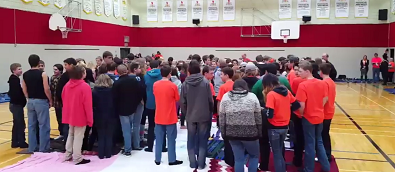Well over a hundred students who gathered in Canwood Public School for Orange Shirt Day on Friday got a crash course in the turbulent history between First Nations people and Europeans.
To give the students from Canwood, Shellbrook, Muskoday, Big River, and Debden a visual of the 500 years of transition from European explorers traveling to Canada to present day, the group did a KAIROS blanket exercise.
The students started out standing on blankets that represent what Turtle Island looked like before Europeans arrived.
Bit by bit the blankets were pulled apart to represent relocation, isolation, displacement, and other colonial acts that pulled First Nations people from their historical way of life.
The students were given identities as either Europeans, First Nations people, or Metis people. They were handed different pieces of paper to represent different traumatic events.
Step by step, most were pulled from the blanket to represent the deaths of Aboriginal people: from starvation, from European-carried diseases, from attending Indian Residential Schools.
The few students who remained were mostly placed outside of the blanket, which represented the loss of connection to home and culture that lands many in prison. Others standing outside the blankets represented First Nations people who lost their status by law because they chose to serve in the army, or go to university.
Non-aboriginal Grade 12 student Delayne Aiken said participating in the exercise opened her eyes.
“Honestly, I didn’t know as many people were affected by the residential schools. I thought it was just kind of, you were sent to school, and that’s how it’s going to be. I didn’t realize the punishments and the impacts that it had on people. And the idea of Turtle Island, I didn’t know that was a thing until I heard about it,” she said.
Orange Shirt Day was the first big event Natasha Isaac has planned since taking on the role of First Nations, Metis and Inuit learning consultant with the Saskatchewan Rivers Public School Division (SRPSD).
Isaac’s family has felt intergenerational effects of residential schools, but she didn’t understand that until she was older.
“Our culture is a mix of who we are, it’s part of our identity. To think about having to lose that, to lose a part of who you were, it devastates me. I can see now why things are the way they are, why things were the way they were. And I didn’t get that opportunity until I was in university to learn all about that,”
Now, she said she is honoured that her job allows her to give younger students a glimpse into the true history of residential schools.
It’s especially important in the SRPSD, where more than half of the student body self-identifies as First Nations and Metis.
The school also had break-down sessions during the day, where residential school survivors told students about their experiences.
